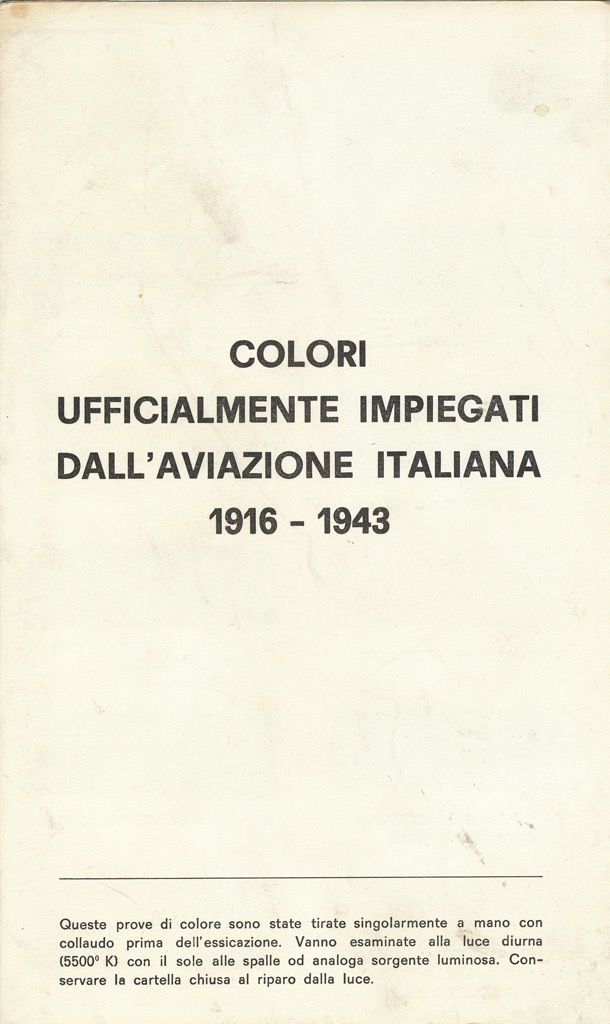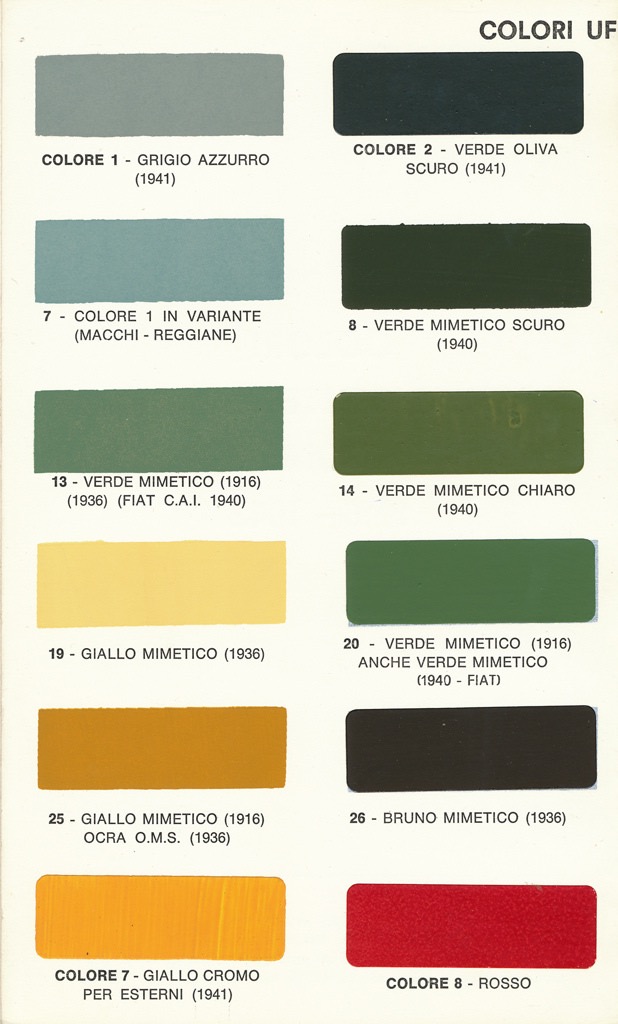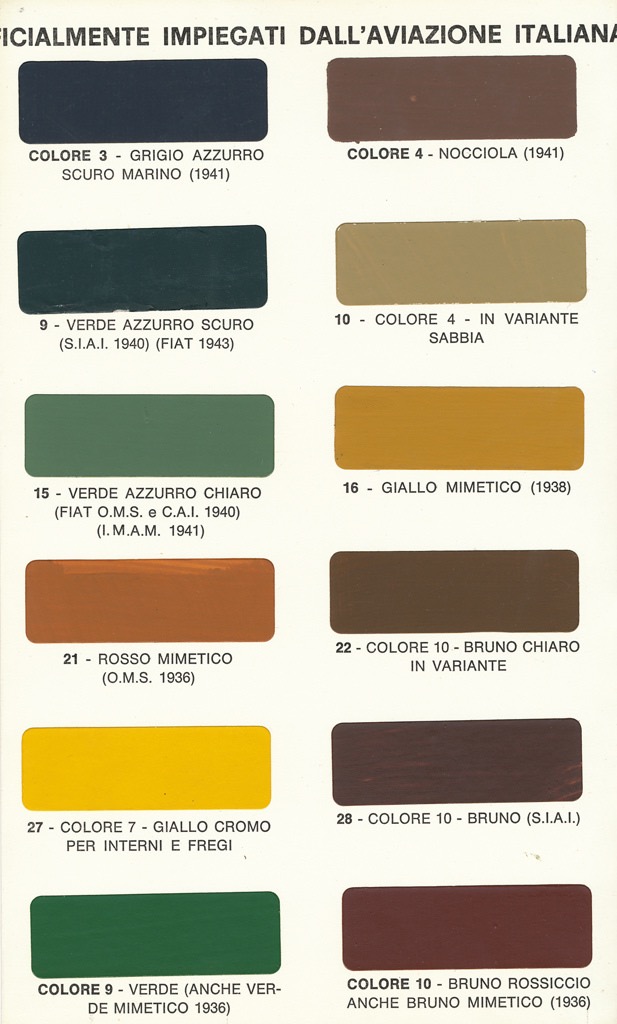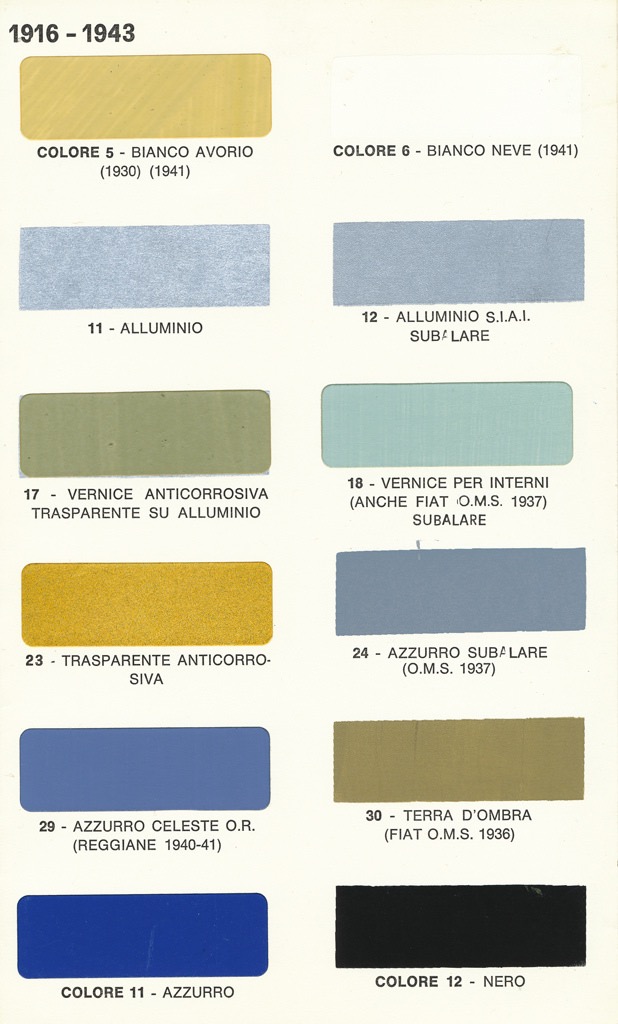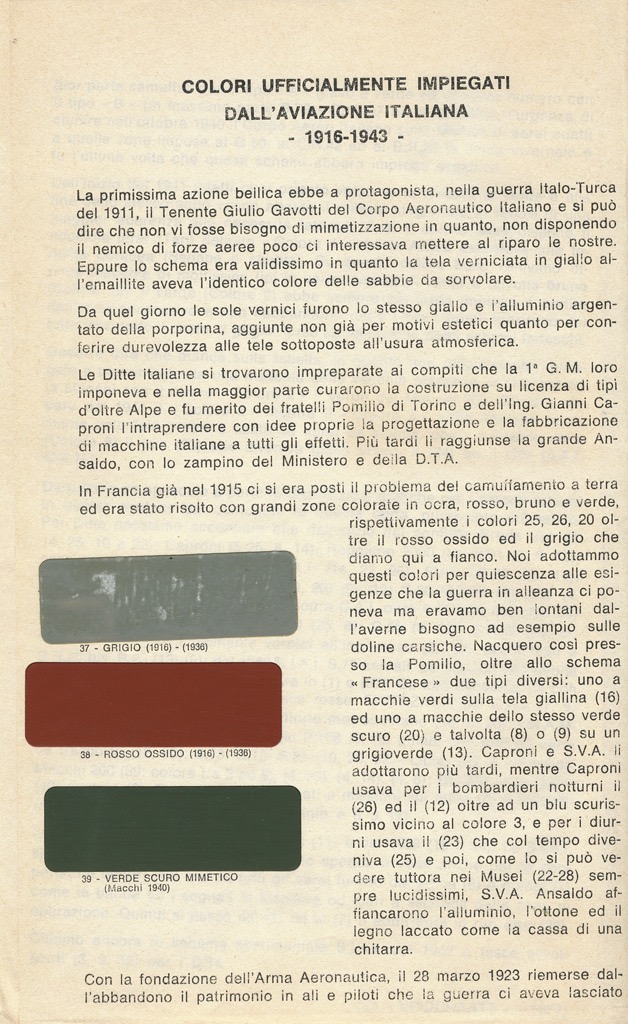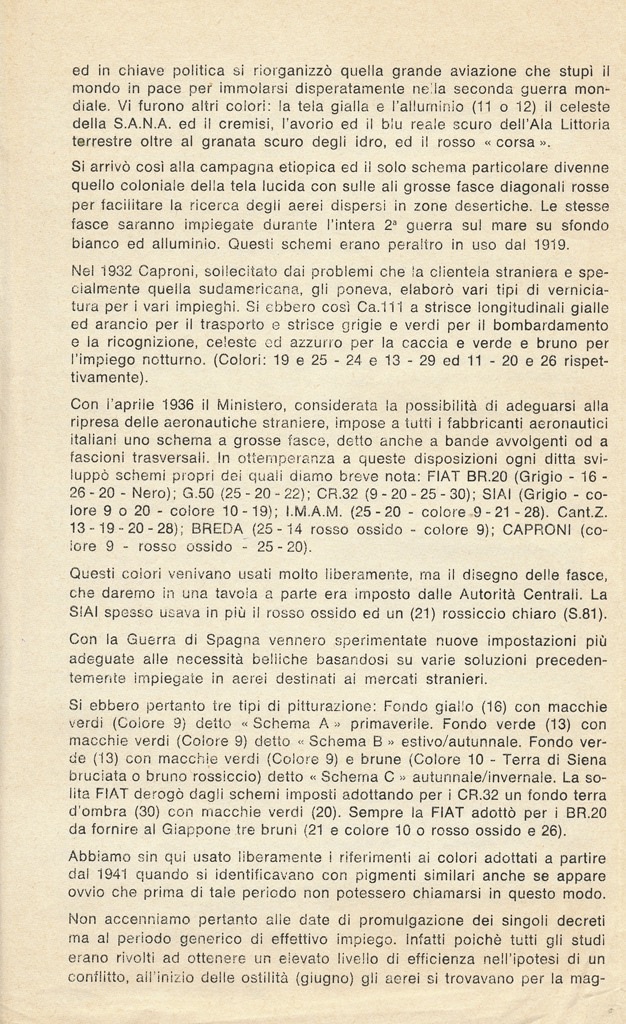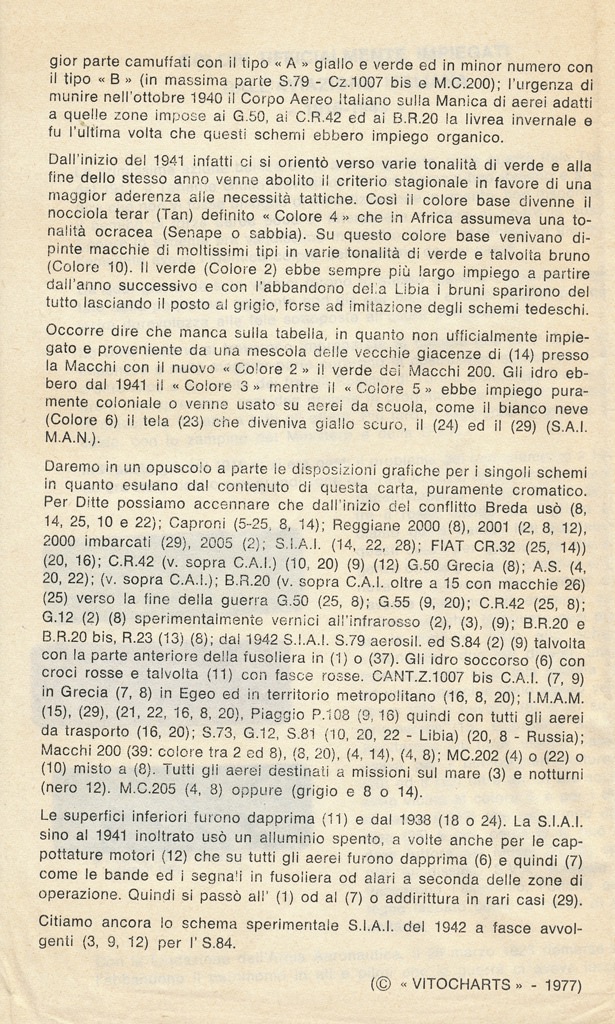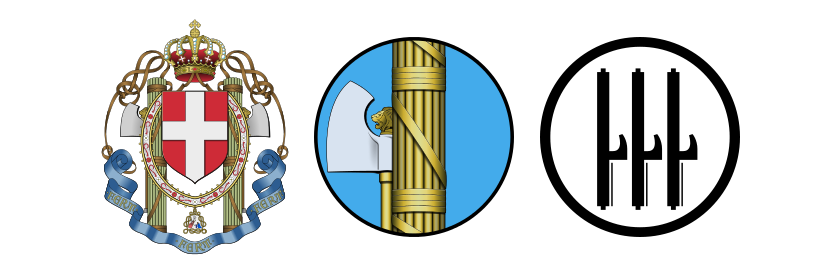
VITOCHARTS Regia Aeronautica 1916-1943
COLORS OFFICIALLY USED BY THE ITALIAN AVIATION
1916 - 1943
These color proofs have been drawn individually by hand with testing before drying. They must be examined in daylight (5500 K) with the sun behind or similar light source. Keep the folder closed away from light.
| Color | RGB | Notes |
|---|---|---|
| COLORE 1 - GRIGIO AZZURRO (1941) | ||
| 7 - COLORE 1 IN VARIANTE (MACCHI - REGGIANE) | ||
| 13 - VERDE MIMETICO (1916) (1936) (FIAT C.A.I. 1940) | ||
| 19 - GIALLO MIMETICO (1936) | ||
| 25 - GIALLO MIMETICO (1916) OCRA O.M.S. (1936) | ||
| COLORE 7 - GIALLO CROMO PER ESTERNI (1941) | ||
| COLORE 2 - VERDE OLIVA SCURO (1941) | ||
| 8 - VERDE MIMETICO SCURO (1940) | ||
| 14 - VERDE MIMETICO CHIARO (1940) | ||
| 20 - VERDE MIMETICO (1916) ANCHE VERDE MIMETICO (1940 - FIAT) | ||
| 26 - BRUNO MIMETICO (1936) | ||
| COLORE 8 - ROSSO | ||
| COLORE 3 - GRIGIO AZZURRO SCURO MARINO (1941) | ||
| 9 - VERDE AZZURRO SCURO (S.I.A.I. 1940) (FIAT 1943) | ||
| 15 - VERDE AZZURRO CHIARO (FIAT O.M.S. e C.A.I. 1940) (I.M.A.M. 1941) | ||
| 21 - ROSSO MIMETICO (O.M.S. 1936) | ||
| 27 - COLORE 7 - GIALLO CROMO PER INTERNI E FREGI | ||
| COLORE 9 - VERDE (ANCHE VERDE MIMETICO 1936) | ||
| COLORE 4 - NOCCIOLA (1941) | ||
| 10 - COLORE 4 - IN VARIANTE SABBIA | ||
| 16 - GIALLO MIMETICO (1938) | ||
| 22 - COLORE 10 - BRUNO CHIARO IN VARIANTE | ||
| 28 - COLORE 10 - BRUNO (S.I.A.I.) | ||
| COLORE 10 - BRUNO ROSSICCIO ANCHE BRUNO MIMETICO (1936) | ||
| COLORE 5 - BIANCO AVORIO (1930) (1941) | ||
| 11 - ALLUMINIO | ||
| 17 - VERNICE ANTICORROSIVA TRASPARENTE SU ALLUMINIO | ||
| 23 - TRASPARENTE ANTICORROSIVA | ||
| 29 - AZZURRO CELESTE O.R. (REGGIANE 1940-41) | ||
| COLORE 11 - AZZURRO | ||
| COLORE 6 - BIANCO NEVE (1941) | ||
| 12 - ALLUMINIO S.I.A.I. SUBALARE | ||
| 18 - VERNICE PER INTERNI (ANCHE FIAT O.M.S. 1937) SUBALARE | ||
| 24 - AZZURRO SUBALARE (O.M.S. 1937) | ||
| 30 - TERRA D'OMBRA (FIAT O.M.S. 1936) | ||
| COLORE 12 - NERO | ||
| 37 - GRIGIO (1916) - (1936) | ||
| 38 - ROSSO OSSIDO (1916) - (1936) | ||
| 39 - VERDE SCURO MIMETICO (Macchi 1940) |
The very first war action had as protagonist, in the Italo-Turkish war of 1911, Lieutenant Giulio Gavotti of the Italian Aeronautical Corps and it can be said that there was no need for camouflage as, not having air forces available to the enemy, we were of little interest in putting I repair ours. Yet, the scheme was very valid as the canvas painted in hematite yellow had the identical color of the sands to fly over.
From that day on the only varnishes were the same yellow and the silvery aluminum of the glitter, added not for aesthetic reasons but rather to give durability to the canvases subjected to atmospheric wear.
The Italian firms found themselves unprepared for the tasks that the 1st World War imposed on them and for the most part they managed the construction under license of types from beyond the Alps and it was thanks to the Pomilio brothers of Turin and Eng. Gianni Caproni to undertake the design and manufacture of fully Italian machines with his own ideas. Later he joined the great Ansaldo, with the hand of the Ministry and the DTA
In France already in 1915 the problem of camouflage on the ground had been posed and it had been solved with large colored areas in ochre, red, brown and green, respectively the colors 25, 26, 20 in addition to the red oxide and the gray that we give here next to. We adopted these colors out of quiescence to the needs that the war in the alliance posed to us but we were far from needing them, for example on karst sinkholes. Thus were born at Pomilio, in addition to the French scheme, two different types: one with green spots on the yellowish cloth (16) and one with spots of the same dark green (20) and sometimes (8) or (9) on a grey-green (13 ).
Caproni and SVA adopted them later, while Caproni used for bombers (26) and (12) as well as a very dark blue close to color 3, and for diurnals he used (23) which over time became (25) and then, as can still be seen in the Museums (22-28) always very lucid, SVA Ansaldo placed side by side aluminum, brass and lacquered wood like the case of a guitar.
With the foundation of the Air Force, on March 23, 1923, the heritage in wings and pilots that had left us in the war re-emerged from abandonment and in a political key that great aviation was reorganized that amazed the world in peace only to sacrifice itself desperately in the Second World War. There were other colors: the yellow canvas and aluminum (II 0 12) the light blue of SANA and the crimson, ivory and royal dark of the terrestrial Ala Littoria as well as the dark garnet of the hydros, and the red «corsa» .
Thus we arrived at the Ethiopian countryside and the; the only particular scheme became the colonial one of the glossy canvas with large red diagonal bands on the wings to facilitate the search for lost planes in desert areas. The same bands will be used during the entire 2nd sea war on a white and aluminum background. However, these schemes had been in use since 1919.
In 1932 Caproni, solicited by the problems that foreign customers and especially the South American one posed to him, developed various types of painting for the various uses. Thus the Ca.lll had yellow and orange longitudinal stripes for transport and gray and green stripes for bombing and reconnaissance, light blue and light blue for hunting and green and brown for night use. (Colours: 19 and 25 -24 and 13 - 29 and 11 -20 and 26 respectively)
In April 1936, the Ministry, considering the possibility of adapting to the resumption of foreign aeronautics, imposed on all Italian aeronautical manufacturers a scheme with large bands, also known as enveloping bands or transversal bands. In compliance with these provisions, each company develops its own schemes of which we briefly note: FIAT BRIO (Grey - 16 - 26 - 20 - Black); G.50 (25 - 20 - 22); CR.32 (9-20-25 - 30); SIAI (Grey - color 9020 - color 10-19); IMAM (25-20 - .9-21 -28). Cant.Z. 13. 19 28); BREDA (25- oxide red - color 9); CAPRONI (colour 9 - oxide red - 25-20).
These colors were used very liberally. but the design of the bands, which we will give in a separate table, was imposed by the Central Authorities. SAI often used oxide red in addition and a light reddish (21) (S.81).
With the Spanish War, new settings were tested that were more suited to wartime needs, based on various solutions previously used in aircraft destined for foreign markets.
There were therefore three types of painting: Yellow background (16) with green spots (Color 2) called Spring Scheme A. Green background (13) with green spots (Color 9) known as summer/autumn "Scheme B". Green background (13) with green (Color 9) and brown (Color 10 - Burnt Sienna or reddish brown) spots called « Scheme C » in autumn/winter. The usual FIAT deviated from the imposed schemes by adopting for the CR.32 an umber ground (30) with green spots (20). FIAT also adopted three browns for the BR.20s to be supplied to Japan (21 and color 0 oxide red and 26).
We have so far freely used the references to the colors adopted starting from 1941 when they identified themselves with similar pigments even if it seems obvious that before this period they could not be called in this way.
We therefore do not mention the dates of promulgation of the individual decrees but the generic period of effective employment. Intact since all the studies were aimed at obtaining a high level of efficiency in the hypothesis of a conflict, at the beginning of the hostilities (June) the planes were for the most part camouflaged with the yellow and green «A» type and to a lesser extent number with type «B» (mostly S.79 - Cz.1007 bis and MC200); the urgency of providing the Italian Air Corps on the Channel in October 1940 with aircraft suitable for those areas bordering on the G_50s, the CR42s and the BR20s with the winter livery and it was the last time that these mockery had organic use.
In fact, from the beginning of 1941 there was a move towards various shades of green and at the end of the same year the seasonal criterion was abolished in favor of greater adherence to tactical needs. Thus the basic color became hazelnut terar (Tan) defined as « Color 4 » which in Africa took on an ocher shade (mustard or sand). On this basic color, spots of many types were painted in various shades of green and sometimes brown (Color 10). Green (Color 2) was increasingly used starting from the following year and with the abandonment of Libya the browns disappeared completely, giving way to grey, perhaps in imitation of the German schemes.
It must be said that it is missing from the table, as it is not officially used and comes from a mix of the old stocks of (14) at Macchi with the new Color 2", the green of the Macchi 200. The hydros had the "Color 3" from 1941 while «Color 5» had a purely colonial use or was used on school planes, such as snow white (Color 6) canvas (23) which became dark yellow, (24) and (29) (SAIMAN).
We will give the graphic layouts for the individual patterns in a separate brochure as they go beyond the purely chromatic content of this paper. For manufacturers, we can mention that since the beginning of the conflict
- Breda used (8, 14, 25, 10 and 22);
- Caproni (5-25, 8, 14);
- Reggiane 2000 2001 (2, 8, 12), 2000 embarked (29), 2005 (2)
- SIAI (14, 22, 28);
- FIAT CR.32 (25, 14)) (20, 16); CR42 (see above CAI) (10, 20) (9) (12) G.50 Greece (8); AS (4, 20, 22); (see above CAI), BR.20 (see above CAI as well as 15 with spots 26) (25) towards the end of the war G.50 (25, 8); G.55 (9, 20); CR42 (25, 8); G.12 (2) (8) experimentally infrared paints (2), (3), (9); BR20 and BR20 bis, R.23 (13) from 1942
- SIAIS79, ed S.84 (2) (9) sometimes with the forward part of the fuselage in (1) or (37). Emergency services (6) with red crosses and sometimes (11) with red bands.
- CANT.Z.1007 bis CAI (7, 9) in Greece (7, 8) in the Aegean and in the metropolitan area (16, 8, 20);
- IMAM (15), (29), (21, 22, 16, 8, 20),
- Piaggio P.108 (2, 13) then with all transport aircraft (16, 20):
- S.73, (3.12, S.81 20, 22 - Libya) (20, 8 - Russia);
- Macchi 200 (39: between 2 Cds 8), 20), (4, 14), (4, 8); MC.202 (4) or (22) or (10) mixed with all aircraft intended for missions over the sea (3) and night (black 12). MC205 (4, 8) or (gray eg 0 14).
The lower surfaces were first (11) and since 1938 (18 0 24). Until well into 1941 SIAI used dull aluminum, sometimes also for the engine cowlings (12) which on all aircraft were first (6) and then (7) like the bands and signals on the fuselage or wing depending on the area of operation. Then we moved on to (1) Or to (7) or even in rare cases (29).
We still mention the SIAI experimental scheme of 1942 with enveloping bands (3, 9, 12) for the S.84.
(c) VITOCHARTS - 1977
